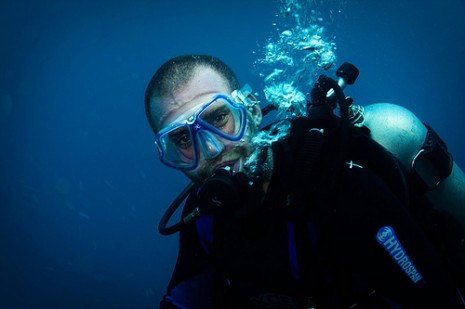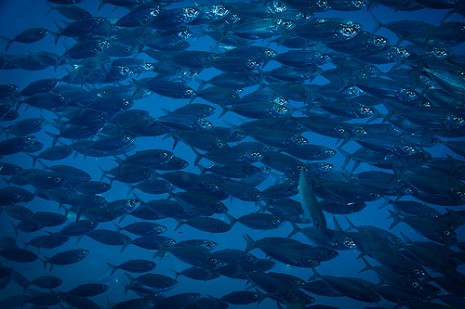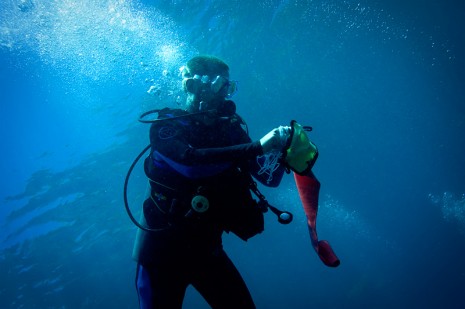While Kelly is a certified Dive Master and has done more than 150 dives during her various travels, I was always somewhat reserved about getting involved in the sport. Partially because it was her hobby and I was into motorcycles, giving us each our own independent, expensive, recreational interests. More so because the idea of submerging yourself underwater with a can of air can be daunting at first. But, given that we’re in such legendary aquatic surroundings, I decided to do a discovery dive.
After getting fitted with a wetsuit, fins, mask, weights, regulator, and BCD (Buoyancy Control Device… basically a vest that fills with air) another couple and I submerged below the surface of the five foot deep pool at the resort and proceeded to learn the basics of diving from Phillip our instructor. Learning to clear the mask when full of water, signs to communicate underwater, how to find the regulator if you should lose it, and basic buoyancy control came to me quickly. So that afternoon we continued the discovery dive in the house reef beside the resort. Lucky for me, the house reef at El Dorado is a marine sanctuary with an abundance of fish, corals, and sea life. Going no deeper than 10 meters, I had an amazing first dive surrounded by all kinds of coral and small fishes. I was even lucky enough to see a turtle. Needless to say, I was hooked and dubbed the ‘Canadian Fish’.
I decided to get my open water certification so the following two nights I spent cramming the SSI course materials. Learning about various equipment, sea life, tides and wave movement, situational dive procedures, and the risks involved in diving and how to minimize them. Each day was spent doing a dive in the house reef and practicing safety skills with Patrick, my replacement instructor, due to Phillip being sidelined by an ear infection. I soon learned that the turtle was a local and was often found in the same spot. We went progressively deeper and dove longer till we were reaching 18 meters with a total dive time of around an hour. Writing the final test was a breeze, and my open water cert should be in the mail!
Following the training I was itching to get out of the house reef and see some of the more than 20 dive sites on the surrounding local beaches and islands. Kelly and I decided to go diving and ended up at the Bahura reef due to poor visibility from the previous evenings typhoon. We saw four or five lion fish, two turtles, some huge nudibranchs (various coloured sea slugs), and many kinds of shrimps and crabs.
A week or so later, we dove at the pier which is a local hot spot for underwater photography. It’s basically underwater wooden pilings holding up the local pier. The pilings are covered in coral and full of sea life. We saw more lion fish, sea horses and pipe fish, a black and white banded sea snake, and some small moray eels.
The following week Kelly and I took a trip to Siquijor for a few days over the Thanksgiving break in lieu of turkey and did four amazing wall dives off of Sandugan beach with another Swiss couple. While Siquijor is quite over fished, we saw many nudibranchs, small fish, and shrimp. I also saw my first frog fish, stone fish, and mandarin fish, as well as some huge soft coral fans. Following all my beach based dives in Dauin which went no deeper than 18 meters, it was nice to get some variation with drift dives along the walls to 25 meters.
Finding that many dive sites here are deeper than the suggested 18 metre limit for open water certification, I decided to get my advanced open water which removes the depth limitation. The first two training dives focused on buoyancy and navigation. Swimming amongst the pilings at the pier, we spotted a blue ringed octopus, a juvenile bat fish, and another stone fish before having to find our way back to the boat using a compass.
The following day, we went to Apo Island for a deep dive, and a drift dive along with five or six other divers. For the first, another trainee and I descended with the instructor to thirty meters at the Chapel where we had to solve a number of math questions and write our names backwards to see if we were experiencing any nitrogen narcosis from being at that depth. Following that, we cracked open a couple of eggs that the instructor had brought down with him and floated the yolks between each other. The pressure is sufficient at that depth to keep it together as it floats from person to person. Pretty funny stuff. We toured the wall on the way up and saw two turtles.
The drift dive was a very different matter. The current was extreme at Coconut Point and we had to work very hard to keep from being swept away from the reef. I worked through half a tank of air in less than 20 minutes and was breathing very hard by the time we got to a sheltered area. I saw a bump head parrot fish that was at least a meter long, but wasn’t able to give it too much attention as we were swept past. By the end of the dive, I had decided that I would avoid most drift dives if this was the norm, but was assured by Kelly and some of the other dive masters that they had never seen the current at Coconut Point sweeping off the reef so strong and that a typical drift dive at Apo was a much more enjoyable experience. It was reassuring in hindsight to realize that I could keep it together in a challenging situation and while tired and out of breath, Apo was a highlight of amazing coral reefs and many types of fish I hadn’t seen elsewhere.
To complete my advanced open water training, we did a night dive tonight. We saw some squid like flamboyant cuttlefish, sponge crabs, and spiny starfish. There was all kinds of activity going on at night and you could get very close to the sleeping fishes before they realized you were there. Also, when diving with lamps you can see the real colours of the coral that are usually not seen under sunlight at depth.
So here I am with fifteen dives under my belt in the last month, I can’t get enough and I am already spoiled by the volume and range of things to see here in the Philippines. The more we talk to divers here, the more places we add to the list to visit. Whale sharks at Donsal. Thresher sharks in Malapasqua. Dolphins and whales in Bais. Not to mention the untouched coastlines surrounding El Nido. As if I needed another reason to stay longer… the larger problem now is how to afford diving every day.
Posted by: Shim











Hey Kelly and Mike,
The article is very interesting. and this is something Joe should read. I just got my open water license in Vancouver about a month ago and dove a few times in around Vancouver. But Joe won’t go and learn dive because he is scared of the bends and the potencial hazards. I have convinced him to do a discovery dive while we are traveling in Zanzibar Tanzania this Nov and hope one day he will go forward. Mike, in your experience, did you think that diving is easier and more interesting than you thought?
Hi Mike, Congratulations on the diving… it sounds fantastic – maybe you could get jobs as a diving instructor… you never know what opportunities will arise – great job on the web-site. Maybe you could try advertising for travel agents??? just a suggestion.
Dad and Carol
Congrats on the open water Maggie! Diving is way more interesting than I initially thought. I’m loving the huge coral walls and all the little creatures are fascinating.
I found learning to dive very easy. A few other people in my class had some initial problems getting used to breathing only through their mouths, and others had problems equalizing pressure or maintaining buoyancy… but other than that, there were very few set backs. If you can swim, you can dive.
I highly recommend Joe do a discovery dive. I was a little intimidated at first as well, but after talking with an instructor about all the safety redundancies that are built into the equipment these days and proper communication underwater, most of my fears were alleviated.
Regarding the bends, air embolisms, etc… On a discovery dive, you won’t go deep enough, long enough to have much chance of developing decompression sickness. Provided you are exhaling regularly upon ascent, there’s very little that can go wrong. Once reading the course materials it will explain how to avoid the dangers of decompression sickness. Understanding the no decompression charts, a dive computer to watch your limits, and breathing regularly are the best advice I can offer.
Good luck getting Joe into the water Maggie! Maybe the warmer waters will help. I hope you have a fantastic trip!
Many thanks for the tips, Mike!!
Hi guys,
I know this blog entry is ancient pretty much, but I stumbled upon your blog, as I was doing some SEO research for our newly started resort in the Philippines. We’re pretty much the same place as you were, in Dumaguete / Dauin. Anyway, I gather from your latest blog entries that you’ve long since moved on – but if you do find your way back to the Philippines, I’d be glad to offer your some free diving (and cold beer) in return for a bit of webwork or something! Just an offer, – if you come this way, have a think about it. If you want to, you can read more about us on http://www.liquiddumaguete.com. Happy diving and safe travels,
Soren